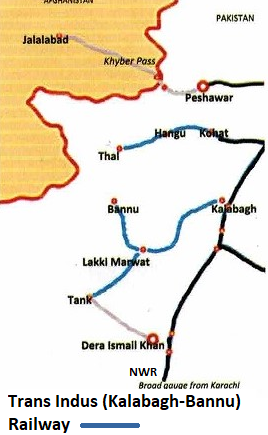Difference between revisions of "Trans Indus (Kalabagh-Bannu) Railway"
(Revised information added with references) |
(Map added, sub heading and text clarified) |
||
| Line 1: | Line 1: | ||
| − | The '''Trans Indus (Kalabagh-Bannu) Railway''' (KBR) was a 2ft 6in/762mm narrow gauge([[Rail_gauge#Narrow_Gauge|NG]]) line, the first section between [[Kalabagh]] and [[Bannu]], 89 miles(142km) opened in 1913 | + | The '''Trans Indus (Kalabagh-Bannu) Railway''' (KBR) was a 2ft 6in/762mm narrow gauge([[Rail_gauge#Narrow_Gauge|NG]]) line, the first section between [[Kalabagh]] and [[Bannu]], 89 miles(142km) opened in 1913. |
| + | [[File:Trans Indus (Kalabagh-Bannu) Railway.png|thumb|'''Trans Indus (Kalabagh-Bannu) Railway''']] | ||
| − | The line initially ran from [[Kalabagh]] where there was a ferry over the Indus River (which was replaced by a bridge in 1931) to [[Bannu]] at the head of the Tochi Valley, which was the main route from India into Afghanistan. Construction of the line had commenced by 1911 using equipment on loan from the [[Light Military Reserve Railway| Light Military Reserve Railway - see separate page for information]] <ref name =IA05>“Industrial Railways and Locomotives of India and South Asia” compiled by Simon Darvill. Published by ‘The Industrial Railway Society’ 2013. ISBN 978 1 901556 82-7. Available at http://irsshop.co.uk/India. Reference: Entry IA05 page ....</ref>. | + | The line initially ran from [[Kalabagh]] where there was a ferry over the Indus River (which was replaced by a bridge in 1931) to [[Bannu]] at the head of the Tochi Valley, which was the main route from India into Afghanistan. Construction of the line had commenced by 1911 using equipment on loan from the [[Light Military Reserve Railway| Light Military Reserve Railway - ''see separate page for information'']] <ref name =IA05>“Industrial Railways and Locomotives of India and South Asia” compiled by Simon Darvill. Published by ‘The Industrial Railway Society’ 2013. ISBN 978 1 901556 82-7. Available at http://irsshop.co.uk/India. Reference: Entry IA05 page ....</ref>. |
In 1913 locomotives were purchased from the [[Kalka-Simla Railway]] for further construction work:- | In 1913 locomotives were purchased from the [[Kalka-Simla Railway]] for further construction work:- | ||
| − | |||
| − | |||
| − | |||
| − | |||
| − | The | + | ==Line Extensions== |
| + | *‘Laki Marwat to Tank Branch Line’ opened in May 1916. This extension was a further 46 miles(73km) to reach [[Tank]] <ref>[https://archive.org/stream/BombayBarodaAndCentralIndiaRailwaySystem/Bombay_Baroda_And_Central_India_Railway_System#page/n137/mode/1up "Administration Report on the Railways in India – corrected up to 31st March 1918"; Superintendent of Government Printing, Calcutta; page 129]; Retrieved 3 Dec 2017</ref> | ||
| + | * ‘Tank to Kaur and Khorgi Branch Line’ commenced during the Warizistan unrest of 1919. This from 1919 and opened in early 1920 <ref>[https://www.irfca.org/docs/locolists/industrial/display.php?file=Military.txt&title=Military%20Trains IRFCA “Military Trains” ''– This has not been corroborated and no further information has been found'']; Retrieved 198 Nov 2018</ref> | ||
| + | *‘[[Tank to Dera Ismail Khan Portable Railway]]’ constructed in 1920 [[Tank to Dera Ismail Khan Portable Railway|- ''see separate page for information'']] | ||
| + | |||
| + | |||
| + | The railways were worked by and finally merged into [[North Western Railway]](NWR) with ownership of the line being passed to NWR in Apr 1921 | ||
==Further Information== | ==Further Information== | ||
Latest revision as of 08:57, 19 November 2018
The Trans Indus (Kalabagh-Bannu) Railway (KBR) was a 2ft 6in/762mm narrow gauge(NG) line, the first section between Kalabagh and Bannu, 89 miles(142km) opened in 1913.
The line initially ran from Kalabagh where there was a ferry over the Indus River (which was replaced by a bridge in 1931) to Bannu at the head of the Tochi Valley, which was the main route from India into Afghanistan. Construction of the line had commenced by 1911 using equipment on loan from the Light Military Reserve Railway - see separate page for information [1].
In 1913 locomotives were purchased from the Kalka-Simla Railway for further construction work:-
Line Extensions
- ‘Laki Marwat to Tank Branch Line’ opened in May 1916. This extension was a further 46 miles(73km) to reach Tank [2]
- ‘Tank to Kaur and Khorgi Branch Line’ commenced during the Warizistan unrest of 1919. This from 1919 and opened in early 1920 [3]
- ‘Tank to Dera Ismail Khan Portable Railway’ constructed in 1920 - see separate page for information
The railways were worked by and finally merged into North Western Railway(NWR) with ownership of the line being passed to NWR in Apr 1921
Further Information
References
- ↑ “Industrial Railways and Locomotives of India and South Asia” compiled by Simon Darvill. Published by ‘The Industrial Railway Society’ 2013. ISBN 978 1 901556 82-7. Available at http://irsshop.co.uk/India. Reference: Entry IA05 page ....
- ↑ "Administration Report on the Railways in India – corrected up to 31st March 1918"; Superintendent of Government Printing, Calcutta; page 129; Retrieved 3 Dec 2017
- ↑ IRFCA “Military Trains” – This has not been corroborated and no further information has been found; Retrieved 198 Nov 2018
